
Narmer was an ancient Egyptian pharaoh of the Early Dynastic Period. He was the successor to the Protodynastic king Ka. Many scholars consider him the unifier of Egypt and founder of the First Dynasty, and in turn the first king of a unified Egypt. He also had a prominently noticeable presence in Canaan, compared to his predecessors and successors. A majority of Egyptologists believe that Narmer was the same person as Menes. Neithhotep is thought to be his queen consort or his daughter.

Nekhen, also known as Hierakonpolis was the religious and political capital of Upper Egypt at the end of prehistoric Egypt and probably also during the Early Dynastic Period.

In Egyptian hieroglyphs, a serekh is a rectangular enclosure representing the niched or gated façade of a palace surmounted by (usually) the Horus falcon, indicating that the text enclosed is a royal name. The serekh was the earliest convention used to set apart the royal name in ancient Egyptian iconography, predating the later and better known cartouche by four dynasties and five to seven hundred years.
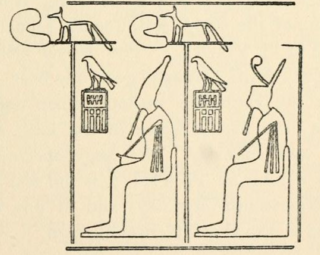
Djer is considered the third pharaoh of the First Dynasty of ancient Egypt in current Egyptology. He lived around the mid 31st century BC and reigned for c. 40 years. A mummified forearm of Djer or his wife was discovered by Egyptologist Flinders Petrie, but was discarded by Émile Brugsch.
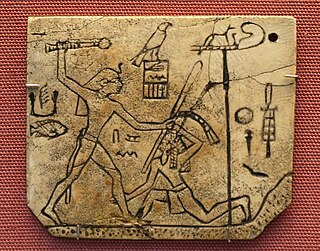
Den, also known as Hor-Den, Dewen, and Udimu, was the Horus name of a pharaoh of the Early Dynastic Period who ruled during the First Dynasty of Egypt. He is the best archaeologically-attested ruler of this period, credited with bringing prosperity to his realm.

Scorpion II, also known as King Scorpion, was a ruler during the Protodynastic Period of Upper Egypt.
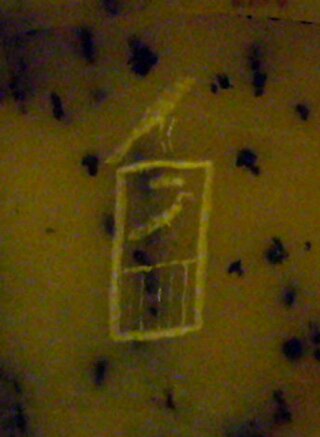
Khaba was a pharaoh of Ancient Egypt, active during the 3rd Dynasty of the Old Kingdom period. The exact time during which Khaba ruled is unknown but may have been around 2670 BC, and almost definitely towards the end of the dynasty.

Iry-Hor was a predynastic pharaoh of Upper Egypt during the 32nd century BC. Excavations at Abydos in the 1980s and 1990s and the discovery in 2012 of an inscription of Iry-Hor in Sinai confirmed his existence. Iry-Hor is the earliest ruler of Egypt known by name and is sometimes cited as the earliest-living historical person known by name.

Nebra or Raneb is the Horus name of the second early Egyptian king of the 2nd Dynasty. The exact length of his reign is unknown since the Turin canon is damaged and the year accounts are lost. Manetho suggests that Nebra's reign lasted 39 years, but Egyptologists question Manetho's view as a misinterpretation or exaggeration of information that was available to him. They credit Nebra with either a 10- or 14-year rule.
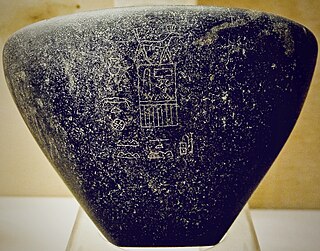
Seth-Peribsen is the serekh name of an early Egyptian monarch (pharaoh), who ruled during the Second Dynasty of Egypt. His chronological position within this dynasty is unknown and it is disputed who ruled both before and after him. The duration of his reign is also unknown.

Anedjib, more correctly Adjib and also known as Hor-Anedjib, Hor-Adjib and Enezib, is the Horus name of an early Egyptian king who ruled during the 1st Dynasty. The Egyptian historian Manetho named him "Miebîdós" and credited him with a reign of 26 years, whilst the Royal Canon of Turin credited him with an implausible reign of 74 years. Egyptologists and historians now consider both records to be exaggerations and generally credit Adjib with a reign of 8–10 years.
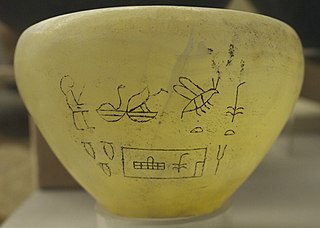
Semerkhet is the Horus name of an early Egyptian king who ruled during the First Dynasty. This ruler became known through a tragic legend handed down by the historian Manetho, who reported that a calamity of some sort occurred during Semerkhet's reign. The archaeological records seem to support the view that Semerkhet had a difficult time as king and some early archaeologists questioned the legitimacy of Semerkhet's succession to the Egyptian throne.

Sekhemib-Perenma'at, is the Horus name of an early Egyptian king who ruled during the 2nd Dynasty. Similar to his predecessor, successor or co-ruler Seth-Peribsen, Sekhemib is contemporarily well attested in archaeological records, but he does not appear in any posthumous document. The exact length of his reign is unknown and his burial site has yet to be found.

Ka, also (alternatively) Sekhen, was a Predynastic pharaoh of Upper Egypt belonging to Dynasty 0. He probably reigned during the first half of the 32nd century BC. The length of his reign is unknown.

The Horus name is the oldest known and used crest of ancient Egyptian rulers. It belongs to the "great five names" of an Egyptian pharaoh. However, modern Egyptologists and linguists are starting to prefer the more neutral term: the "serekh name". This is because not every pharaoh placed the falcon, which symbolizes the deity Horus, atop his serekh.

Neithhotep or Neith-hotep was an ancient Egyptian queen consort who lived and ruled during the early First Dynasty. She was once thought to be a male ruler: her outstandingly large mastaba and the royal serekh surrounding her name on several seal impressions previously led Egyptologists and historians to the erroneous belief that she might have been an unknown king. As the understanding of early Egyptian writings developed, scholars learned that Neithhotep was in fact a woman of extraordinary rank. She was subsequently considered to be the wife of unified Egypt's first pharaoh, Narmer, and the mother of Hor-Aha.

Sneferka was an early Egyptian king who may have ruled at the end of the 1st Dynasty. The exact length of his reign is unknown, but thought to have been very short and his chronological position is unclear.

Double Falcon was a ruler of Lower Egypt from Naqada III. He may have reigned during the 32nd century BC. The length of his reign is unknown.

Ny-Hor was a possible pharaoh from the Predynastic Period. His name means "The Hunter" according to egyptologist Werner Kaiser. He may have ruled during the 31st century BC.

Wash was possibly a pharaoh from the Predynastic Period in Ancient Egypt, approximately 5,000 years ago. As Wash is known only through his appearance as a captive of the pharaoh Narmer on the eponymous palette, his existence is contested.




















